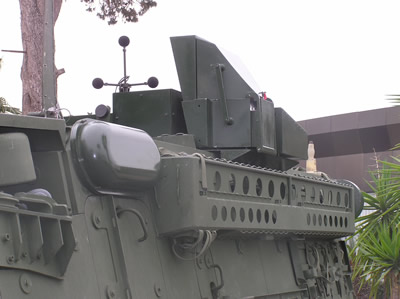Operation Homat Magen provided the first lessons in large-scale operations in Urban-LIC. These lessons were incorporated into the development and adaptation of intelligence gathering, command and control and combat support systems. One of the many results of these lessons was the fielding of new door and wall breeching equipment, originally developed for special operations, but now issued as standard equipment to the infantry units. These systems include the ‘Simon’ door breeching grenade, which has since been fielded by a number of western military organizations, including the US Marine Corps, and US and British Armies.
Israel is sharing experience and R&D on urban warfare related systems. “What began as a cooperative research and ‘lessons learned’ cooperation effort between the US and Israeli governments evolved into industrial teaming for major development programs, involving RAFAEL and General Dynamics”. Col (Res.) Nimrod Ran, RAFAEL’s Urban Warfare Program Director told Defense Update. RAFAEL (teamed with General Dynamics) and IMI (teaming with Lockheed Martin) have submitted competing proposals for the USMC Follow-On to SMAW (FOTS) and future US Army Bunker Defeat Munition (BDM) programs and are expected to follow with similar programs for future Army programs.
Operation Homat Magen also overwhelmed the terrorist organizations in the West Bank, buying essential time for the creation of the security fence, which is expected to reduce the vulnerability of Israel’s population centers to Palestinian suicide attacks.

A different situation developed on the Southern front. To bypass the terrestrial barriers erected by the IDF along the perimeter of the Gaza strip, the Palestinians adopted new tactics using ballistic weapons firing improvised Rockets and Mortars (RAM) at civilian Israeli targets within range of their operational area. These attacks increased to intolerable levels, forcing the IDF to enter the segregated Gaza strip area in search of rocket/mortar firing teams and their support structure. The Palestinians quickly retreated into the cities and camps, where they tried to trap IDF armor in deadly ambushes. The weapons used were improvised landmines and IEDs, which scored several deadly hits, even against the Merkava, Israel’s heaviest tank. The flat, sandy terrain enabled extensive underground activity, facilitating covert movement between buildings. Tunnels also provided logistical supply channels for military equipment, as well as subterranean approach routes for attacks against Israeli outposts.
Security operations in the Gaza strip involved continuous conflict with insurgents. Palestinian attacks were directed at fortified outposts, installations, patrols and supplies, as well as civilian settlements. Escalating through a continuous pattern of attack and response, the IDF implemented layer upon layer of defenses to its vehicles. They added armor to tanks after several attacks against tanks. They also added protected armored fighting compartments to armored personnel carriers, and peripheral cameras, to enable improved situational awareness and responsive fighting capability by mechanized infantry.
Novel tactical approaches were introduced for armor. Merkava tanks are equipped with a window and firing hatch in the rear door, enabling snipers to guard the rear section of the tank. Another modification to the Merkava was the installation of a medical kit, for use during evacuation of wounded soldiers under fire. Belly armor was added to tanks, protecting against buried shaped charge IEDs weighing over 100 pounds. Following the destruction of two explosive loaded M-113s operated by Combat Engineer troops, the IDF improved the protection of its M-113s, introducing an enhanced composite armor suite utilizing reactive and passive protection. The new Trophy active protection system developed for IDF Merkava tanks was modified to fit medium and light armored vehicles, and has now been re-designed to protect the Stryker Armored Fighting Vehicle (AFV).
Additional parts of this article:
- Urban Combat – The Israeli Experience
- Israeli LIC Operations in Samaria
- Urban Combat Operations in Samaria (cont.)
- New Equipment for Urban Warfare fielded by the Israeli Army
- Israel, Palestinians Practice New Operational Concepts in Urban Warfare
- I.D.F Urban Warfare Battalion – Yata
- IDF Fields New C4 Equipment Optimized for urban Combat
- Israeli Army Tests New ISR Systems for Urban Warfare
- Israel Practice New Concepts for Airborne, Urban Area Domination





















